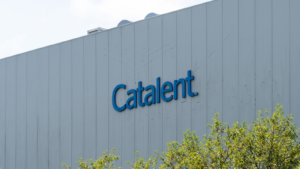
S&P 500 companies collectively saw second-quarter earnings fall by 4% over last year. A big problem for the index constituents is the higher interest expenses that are eating into corporate profits. This has generated a longer list of S&P 500 stocks to sell.
Interestingly, the average S&P 500 company generated $7.60 of operating profits for every dollar of interest expense in Q2. That’s down from more than $10 in the post-pandemic peak, as Barron’s reported Ned Davis Research’s findings in late August.
S&P 500 companies are hoping that interest rates slow down. They also expect the economy will keep chugging along so operating profits increase and higher interest expenses don’t consume profits. If rates stay elevated well into 2024 or even 2025, and debt burdens remain high, stocks and bonds could get hit.
Let’s examine three debt-ridden S&P 500 stocks you want to sell before it’s too late.
Catalent (CTLT)

You wouldn’t know it from Catalent’s (NYSE:CTLT) year-to-date (YTD) returns, which are up more than 9%. In reality, it’s on a serious downer, losing 27% of its value over the past six months.
Catalent, for those unfamiliar, is a Contract Development and Manufacturing Organization (CDMO). It helps drug companies manufacture products at more than 50 sites worldwide. In 2022, it had nearly $5 billion in revenue.
Manufacturing pharmaceuticals isn’t cheap. It takes precise manufacturing equipment. That’s the reason the company finished Q4 2023 with $4.58 billion in net debt, resulting in $184 million in interest expenses in the fiscal year.
Its earnings before interest and taxes in 2023 were $73 million. CTLT doesn’t have much leeway in the future should interest rates remain high. The one positive is that almost 90% of its debt matures in 2028 or later, when interest rates could be much lower.
Surprisingly, and probably because of the healthcare connection, analysts remain optimistic about its stock. Of the 19 analysts rating CTLT, seven rate it “overweight” or “buy”. However, that doesn’t mean you should buy it. The median target price is $50, or 30 cents above where it’s currently trading.
Stanley Black & Decker (SWK)

Stanley Black & Decker (NYSE:SWK) has seen better days. First, a brief backstory.
My wife runs a construction company with her business partner. He’s been a carpenter for nearly 40 years. He loves DeWalt tools. That’s all he uses.
Black & Decker originally bought DeWalt in 1960 and then sold the product line in 1989 but hung onto the name. It slapped the DeWalt name on its professional line of tools three years later, and DeWalt was reborn.
The company got quite a bit larger in 2010 when The Stanley Works acquired it for $4.5 billion, a 22% premium. The merged entity became Stanley Black & Decker, with Stanley shareholders owning 50.5% and Black & Decker owning 49.5%.
When the deal was announced, Stanley shares were trading at $49. We’re coming up to the 14th anniversary. SWK shares have increased by 91%. That sounds good until you realize the S&P 500 is up 309% over the same period. In addition, SWK debt ballooned from $1.09 billion in 2009 to $5.35 billion in 2022, a compound annual growth rate of 12.0%.
Thus, the company ranks as one to sell now.
International Flavors & Fragrances (IFF)

International Flavors & Fragrances (NYSE:IFF) has the ability to create flavors and fragrances for other people’s products. This is a genius, seemingly profitable business idea.
And yet, IFF is down 33% YTD and 44% over the past five years.
What’s the problem? The total debt stands at $11.3 billion, and the $190.5 million in net interest expense has ostensibly doubled over the past year. The debt levels jumped in February 2021 when it merged with DuPont’s Nutrition & Biosciences business.
“The combination of IFF and N&B creates a global leader in high-value ingredients and solutions for the Food & Beverage, Home & Personal Care and Health & Wellness markets, with estimated 2020 pro forma revenue of more than $11 billion and EBITDA of approximately $2.5 billion, excluding synergies,” stated the Feb. 1, 2021, press release announcing the completion of the merger.
It cost International Flavors & Fragrances dearly, paying DuPont $7.3 billion in cash. However, DuPont shareholders owned 55.4% of the merged entity, with IFF shareholders owning 44.6%.
Today, it has $11.9 billion in sales and -$424 million in EBITDA. Talk about value destruction.
On the date of publication, Will Ashworth did not have (either directly or indirectly) any positions in the securities mentioned in this article. The opinions expressed in this article are those of the writer, subject to the InvestorPlace.com Publishing Guidelines




